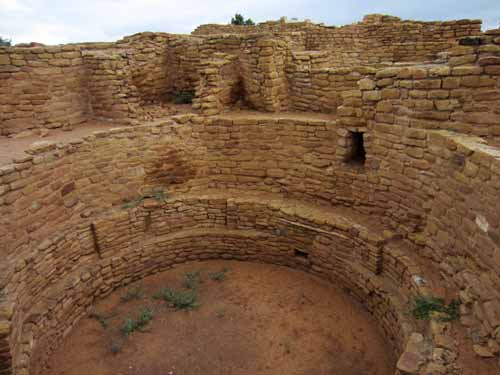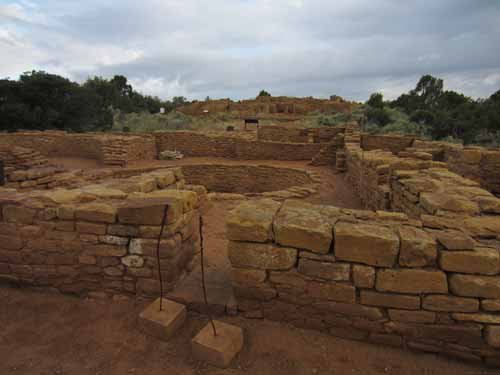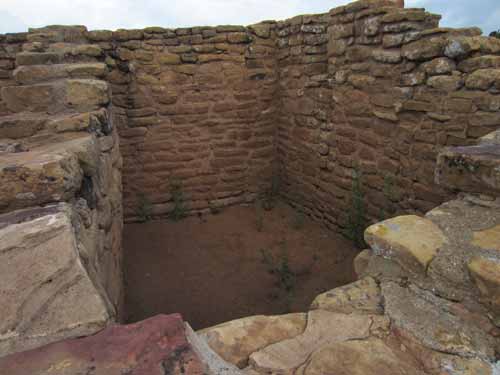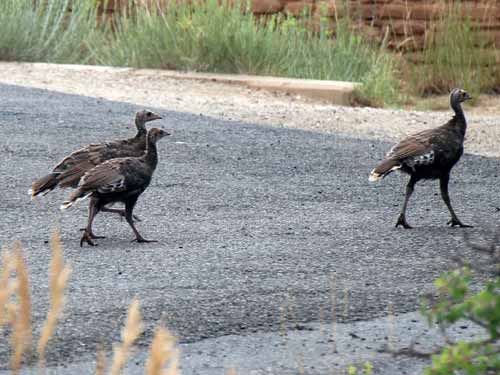

Again, the deer were abundant.

Our next tour, the Cliff Palace, was at 9 am at the end of the Chapin Mesa. It was a bit of a drive but we had enough time to make a stop at the Far View Sites.
The Far View community is made up of numerous sites. In the early days, this was one of the most densely populated parts of the mesa. Nearly 50 villages have been identified within a 1/2 square mile area. Six of them have been excavated and show continuous occupation from 750 - 1300. The growing season was probably shorter here, but the additional moisture (from being at this higher elevation) probably made the crops more successful.

Map of the ruins

The Far View House was the first mesa top site excavated. Work began in 1916 and was completed in less than 4 months. According to Dr. Jesse Walter Fewkes, the primary archeologist overseeing the task, this dwelling consisted of over 50 rooms. Tree ring dates indicate it was built around the year 1000 and occupied for nearly 300 years. Other wood recovered indicated that there was most likely an older structure beneath it.

The Far View House before excavation. 1916

Excavating using a horse-drawn earth mover called a fresno. 1916

Far View House was up to 3 stories high.

Another one for my collection!

The Far View House had very tall walls...

... and a very large, deep kiva!

The shed skin of a snake

The Pipe Shrine House was right next door. It was named after some pottery found at the site.



The lower walls made it easier to see the building's layout.

A circular plaza overlooks a kiva.

Looking over the Pipe Shrine House back at the Far View House

This was hardly a doorway...more like a crawlway.

Other rooms had no entrance ways at all.


A set of stairs
It was a short walk through the forest to Coyote Village.


The expansive village
Many of today's Pueblo societies are matrilineal and matrilocal. This means the property and clan affiliation are passed down through the female line. When a man marries, he moves in with his wife's family. He builds the house but she is the owner because she repairs and preserves it. He cultivates the field she she keeps the harvest.



Inisde a kiva. This is the first time we've seen any wood beams inside.

Some walls are built up to, but not into, other walls. This is called at abutment and implies that the wall was built at a later date.


A carefully chiseled brick.





A passageway into the kiva


The use of wooden poles in construction
Walking over to the next set of ruins, I discovered a large family of turkeys loitering by my car. The chicks fled as soon as they saw me, but mom (or dad) took her time slowly strolling away.

The young 'uns hurried back to the safety of the shrubbery.

Mom takes her time.

The family reunites back at the safety of the tall grass.
Next... Far View Tower
These circular towers must have had an important role in the community, but its function is lost in time and unknown to us. There were only built during the later phases of construction, 1100 - 1300, and are not found in modern pueblos.
Mummy Lake or the Fair View Reservoir - Mesa Verde averages about 17 inches of moisture per year. While there is no evidence that the agricultural fields were ever irrigated, the Ancestral Puebloans did construct an extensive network of ditches, canals and reservoirs to collect and store rainwater for domestic use.

